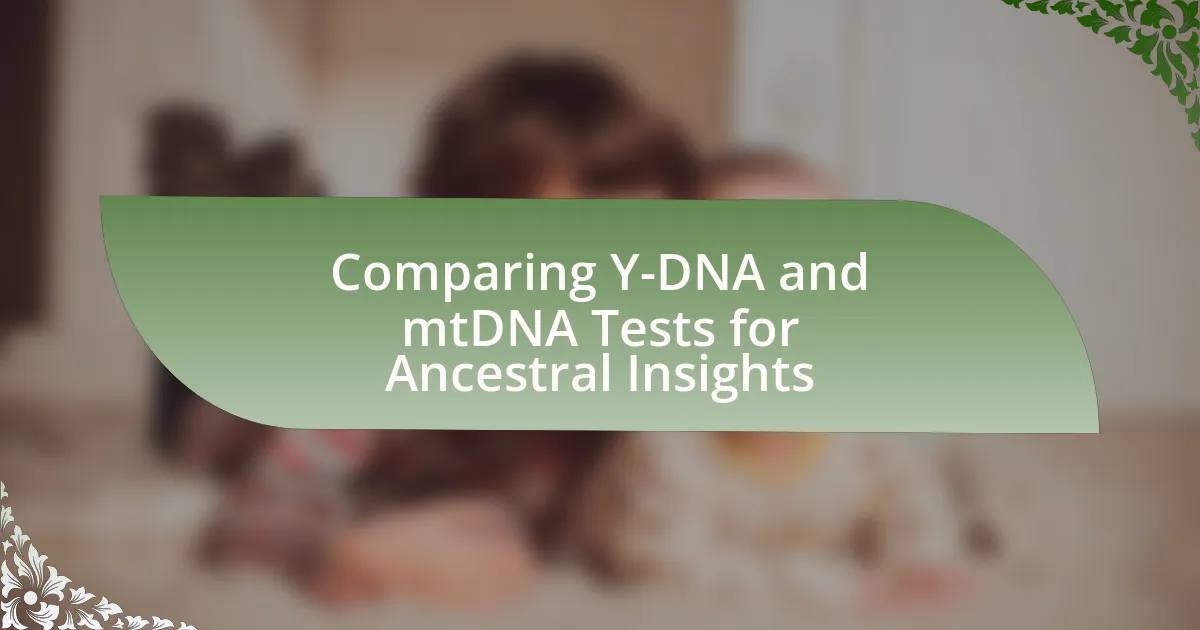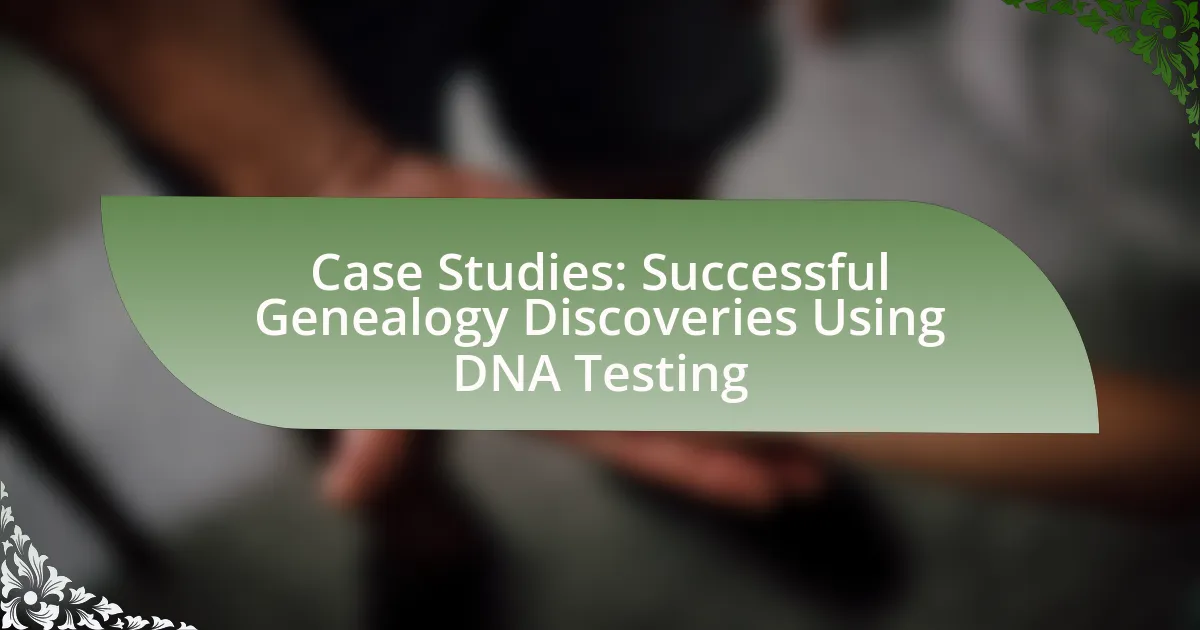DNA testing is a pivotal tool in tracing ancestry, offering genetic insights that reveal familial connections and ancestral origins. The article explores how various DNA tests, including autosomal, Y-DNA, and mitochondrial DNA tests, contribute to understanding lineage and ethnic backgrounds. It discusses the advantages of DNA testing in genealogical research, its limitations, and the ethical considerations surrounding privacy and data usage. Additionally, the article highlights the evolution of DNA testing technology and public interest, providing practical tips for individuals considering ancestry DNA testing.
What is the Role of DNA Testing in Tracing Ancestry?

DNA testing plays a crucial role in tracing ancestry by providing genetic information that can reveal familial connections and ancestral origins. Through the analysis of specific markers in an individual’s DNA, such as mitochondrial DNA and Y-chromosome DNA, researchers can identify lineage and migration patterns of ancestors. Studies have shown that DNA testing can uncover previously unknown relatives and confirm or refute family trees constructed through traditional genealogical methods. For instance, a 2018 study published in the journal “Nature” highlighted how DNA testing can trace back to common ancestors, demonstrating the effectiveness of genetic analysis in understanding one’s heritage.
How does DNA testing contribute to understanding ancestry?
DNA testing significantly enhances the understanding of ancestry by providing genetic evidence that traces lineage and heritage. Through the analysis of specific markers in an individual’s DNA, such as mitochondrial DNA and Y-chromosome DNA, researchers can identify ancestral origins and migration patterns. For instance, studies have shown that mitochondrial DNA is passed down maternally, allowing for the tracing of maternal lineage over generations. Additionally, Y-chromosome analysis can reveal paternal ancestry, as it is inherited unchanged from father to son. This genetic information can be compared against databases containing DNA from various populations, enabling individuals to discover their ethnic backgrounds and familial connections.
What types of DNA tests are used for ancestry tracing?
The types of DNA tests used for ancestry tracing include autosomal DNA tests, Y-DNA tests, and mitochondrial DNA tests. Autosomal DNA tests analyze the 22 pairs of non-sex chromosomes inherited from both parents, providing a broad overview of ancestry from all ancestral lines. Y-DNA tests specifically examine the Y chromosome, which is passed from father to son, allowing for paternal lineage tracing. Mitochondrial DNA tests focus on mitochondrial DNA, which is inherited from the mother, enabling maternal lineage tracing. These tests collectively help individuals uncover their ancestral origins and familial connections.
How do different DNA testing methods yield varying results?
Different DNA testing methods yield varying results due to differences in the types of genetic information they analyze. For instance, autosomal DNA tests examine chromosomes inherited from both parents, providing a broad view of ancestry, while Y-DNA tests focus solely on the paternal lineage by analyzing the Y chromosome, and mitochondrial DNA tests trace maternal ancestry through mitochondrial genes. Each method has its own strengths and limitations, leading to distinct insights about an individual’s ancestry. For example, autosomal tests can identify relatives across multiple generations, while Y-DNA and mitochondrial tests are limited to direct paternal or maternal lines, respectively. This specificity results in different interpretations of ancestry and genetic heritage, highlighting the importance of selecting the appropriate testing method based on the desired information.
Why is DNA testing important for genealogical research?
DNA testing is important for genealogical research because it provides concrete evidence of biological relationships and ancestry. By analyzing genetic markers, individuals can uncover familial connections that may not be documented in historical records. Studies have shown that DNA testing can reveal previously unknown relatives, confirm lineage, and even trace ancestry back several generations, offering insights that traditional genealogical methods may miss. For instance, a 2019 study published in the journal “Nature” highlighted how DNA testing helped individuals connect with relatives across continents, demonstrating its effectiveness in expanding genealogical knowledge.
What insights can DNA testing provide about family history?
DNA testing can provide insights into family history by revealing genetic connections and ancestral origins. Through analysis of specific markers in an individual’s DNA, testing can identify relatives, trace lineage, and uncover ethnic backgrounds. For instance, autosomal DNA tests can connect individuals with shared ancestors within the last few generations, while Y-DNA and mitochondrial DNA tests can trace paternal and maternal lines, respectively. Studies have shown that DNA testing can accurately determine heritage, with companies reporting that over 80% of users discover new relatives or ancestral information that was previously unknown.
How does DNA testing complement traditional genealogy methods?
DNA testing complements traditional genealogy methods by providing genetic evidence that can confirm or clarify familial relationships. While traditional genealogy relies on historical records, such as birth certificates and census data, DNA testing offers a biological basis for ancestry that can reveal connections not documented in written records. For instance, DNA tests can identify unknown relatives and help trace lineage back further than traditional methods alone, as evidenced by studies showing that genetic matches can lead to the discovery of relatives who share significant portions of DNA, thus validating or challenging existing family trees.
What are the limitations of DNA testing in ancestry tracing?
DNA testing in ancestry tracing has several limitations, including the inability to provide a complete family history, potential inaccuracies in ethnicity estimates, and privacy concerns. While DNA tests can reveal genetic connections and ancestral origins, they often lack the depth of genealogical records, which can lead to incomplete or misleading conclusions about an individual’s ancestry. Ethnicity estimates can vary significantly between different testing companies due to differing reference populations and algorithms, resulting in inconsistent results. Additionally, privacy issues arise as individuals may not fully understand how their genetic data is stored, shared, or used, raising concerns about consent and data security.
What factors can affect the accuracy of DNA test results?
The accuracy of DNA test results can be affected by several factors, including sample contamination, the quality of the DNA sample, the testing methodology used, and the interpretation of results. Sample contamination occurs when foreign DNA is introduced, which can lead to incorrect conclusions. The quality of the DNA sample, such as degradation or insufficient quantity, can hinder accurate analysis. Different testing methodologies, such as SNP analysis versus whole genome sequencing, can yield varying results, impacting accuracy. Lastly, the interpretation of results can be influenced by the reference databases used, which may not represent all populations adequately, leading to potential misinterpretations of ancestry.
How do privacy concerns impact the use of DNA testing for ancestry?
Privacy concerns significantly impact the use of DNA testing for ancestry by causing individuals to hesitate in sharing their genetic information. Many potential users fear that their DNA data could be misused, leading to unauthorized access, discrimination, or breaches of confidentiality. A survey conducted by the Pew Research Center in 2019 found that 60% of Americans expressed concern about how companies handle their genetic data, highlighting the widespread apprehension regarding privacy. This fear can result in decreased participation in DNA testing services, ultimately limiting the effectiveness of these tools in tracing ancestry and understanding genetic heritage.
How has DNA testing evolved in the context of ancestry?
DNA testing has evolved significantly in the context of ancestry by transitioning from basic genetic markers to comprehensive genomic analysis. Initially, ancestry DNA tests focused on mitochondrial DNA and Y-chromosome analysis, which provided limited insights into maternal and paternal lineages. Over time, advancements in technology have enabled the analysis of autosomal DNA, allowing individuals to trace their ancestry across multiple generations and identify genetic connections with a broader range of relatives.
The introduction of direct-to-consumer DNA testing services, such as AncestryDNA and 23andMe, has democratized access to genetic information, making it easier for individuals to explore their heritage. These services utilize large databases and sophisticated algorithms to provide detailed ethnicity estimates and potential familial connections, enhancing the understanding of personal ancestry.
As of 2023, the integration of artificial intelligence and machine learning in DNA analysis has further refined the accuracy of ancestry predictions, allowing for more precise identification of ancestral origins and migration patterns. This evolution reflects a growing interest in genealogy and personal history, supported by a substantial increase in consumer participation in DNA testing.
What technological advancements have improved DNA testing?
Technological advancements that have improved DNA testing include next-generation sequencing (NGS), polymerase chain reaction (PCR) enhancements, and bioinformatics tools. Next-generation sequencing allows for rapid and cost-effective analysis of entire genomes, significantly increasing the amount of genetic data that can be processed simultaneously. Polymerase chain reaction advancements have improved the sensitivity and specificity of DNA amplification, enabling the detection of minute quantities of DNA. Additionally, bioinformatics tools facilitate the analysis and interpretation of complex genetic data, making it easier to trace ancestry and identify genetic relationships. These advancements collectively enhance the accuracy, efficiency, and accessibility of DNA testing for ancestry purposes.
How has public interest in DNA testing changed over time?
Public interest in DNA testing has significantly increased over time, particularly since the early 2000s. The introduction of direct-to-consumer DNA testing kits, such as those from companies like AncestryDNA and 23andMe, has driven this surge, with millions of consumers purchasing these kits for ancestry tracing and health insights. According to a 2021 survey by the Pew Research Center, 44% of Americans reported having taken a DNA test, a notable rise from just 23% in 2018. This growing interest reflects a broader societal trend towards personal genomics and the desire for individuals to connect with their heritage and understand their genetic backgrounds.
What are the ethical considerations surrounding DNA testing for ancestry?
Ethical considerations surrounding DNA testing for ancestry include privacy concerns, informed consent, and potential misuse of genetic information. Privacy concerns arise because individuals may not fully understand how their genetic data will be stored, shared, or used by testing companies, leading to risks of unauthorized access or data breaches. Informed consent is crucial, as individuals must be aware of what they are agreeing to when submitting their DNA, including the implications of discovering unexpected familial relationships or health-related information. Additionally, there is a risk of genetic data being used for discriminatory purposes, such as in employment or insurance, which raises significant ethical questions about the protection of individuals’ rights and identities.
How do consent and data usage policies affect participants?
Consent and data usage policies significantly affect participants by determining how their genetic information is collected, stored, and utilized. These policies establish the legal framework that governs participant rights, including the ability to withdraw consent and the transparency of data usage. For instance, a study published in the journal “Genetics in Medicine” highlights that clear consent processes enhance participant trust and willingness to share genetic data, as individuals feel more secure knowing how their information will be used and protected. Additionally, stringent data usage policies can mitigate risks of misuse or unauthorized access, thereby safeguarding participant privacy and fostering a more ethical approach to DNA testing in ancestry research.
What role do genetic counselors play in ancestry DNA testing?
Genetic counselors play a crucial role in ancestry DNA testing by providing expert guidance and interpretation of genetic results. They help individuals understand the implications of their ancestry findings, including potential health risks and the significance of genetic connections to relatives. Genetic counselors also assist in addressing emotional responses to ancestry discoveries and can facilitate informed decision-making regarding further testing or family discussions. Their expertise ensures that individuals receive accurate information and support throughout the ancestry exploration process.
What practical tips should individuals consider before taking a DNA test for ancestry?
Individuals should consider the following practical tips before taking a DNA test for ancestry: first, research the different DNA testing companies and their specific offerings, as each may provide varying levels of detail and types of ancestry information. For example, some companies focus on autosomal DNA, while others may offer Y-DNA or mitochondrial DNA testing, which can yield different insights into lineage.
Next, individuals should understand the privacy policies and data usage agreements of the testing companies, as personal genetic information can be sensitive and may be shared with third parties. Additionally, it is important to consider the potential emotional impact of discovering unexpected ancestry results, which could include surprises about family heritage or connections.
Lastly, individuals should prepare for the possibility of connecting with unknown relatives, as DNA testing can lead to new family discoveries that may require navigating complex family dynamics.
How can individuals choose the right DNA testing service for their needs?
Individuals can choose the right DNA testing service by assessing their specific needs, such as ancestry tracing, health insights, or genetic traits. They should compare services based on the type of DNA tested (autosomal, Y-DNA, or mtDNA), the comprehensiveness of the database for ancestry matching, and the clarity of the results provided. Additionally, individuals should consider the privacy policies of the service, the cost of testing, and customer reviews to ensure reliability and satisfaction. For instance, companies like AncestryDNA and 23andMe offer extensive databases and user-friendly reports, making them popular choices for ancestry tracing.
What steps should be taken to interpret and use DNA test results effectively?
To interpret and use DNA test results effectively, individuals should first understand the type of DNA test they have taken, such as autosomal, Y-DNA, or mitochondrial DNA tests, as each provides different information about ancestry. Next, they should analyze the results by comparing them with reference populations and identifying genetic matches, which can reveal potential relatives and ancestral origins. It is also important to utilize online platforms and databases that allow for further exploration of genetic connections and historical context. Finally, individuals should consider consulting with genetic counselors or genealogists for professional insights, especially when navigating complex results or health-related implications.




